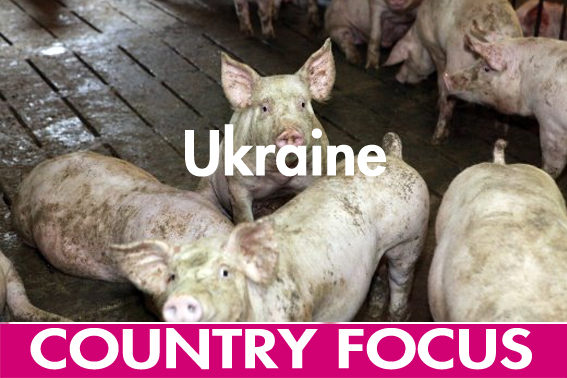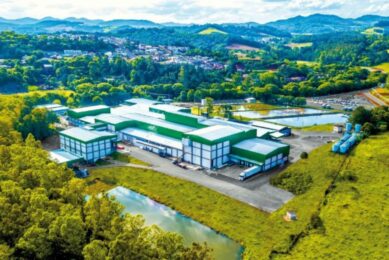Ukrainian pig sector facing an uncertain future

Last year saw a spike in geopolitical and economic challenges for the Ukrainian pig industry. Coupled with rising fears from the spread of diseases, this means that the sector is facing an uncertain future.
As with many businesses in the Ukraine, it is nearly impossible to predict the immediate future for the pork business. In the current uncertain times, extrapolating figures is like playing Russian roulette. Take for instance the country’s pork consumption pattern. In 2013, the total consumption of pork and pork products in the Ukraine was the highest ever and amounted to 990,000 tonnes. Last year, it dropped to 890,000 tonnes.
An optimistic forecast of the Ukrainian Association of Pig Producers (APP) states that, for 2015, this figure might not change, while pessimistic projections speak of falling average incomes, which will make these figures drop further to around 800,000 tonnes. Who is right? Another example: Ukraine’s pig production. Even as late as 2014, several new pig farms were commissioned.
This enabled the country to boost the total volume of production from 765,000 tonnes in 2013 to 805,000. The Food and Agriculture Organisation (FAO) and the APP even forecast a 14% growth between 2015 and 2020. Again, here one may wonder whether these predictions are perhaps too optimistic. Other market participants anticipate an annual growth of pork production in the country during the corresponding period to be about 1.5-2%.
Challenging factors effecting the pig industry
Ukraine is currently facing many challenges which are having a knock-on effect on its pig industry, including a period of conflict. The Russian annexation of the Ukrainian peninsula, the Crimea, and the armed conflict in the south-east regions of the country have had a slight effect on domestic pig producers. But because pig farms in the Crimea only produce about 30,000 tonnes of pork annually, the loss of this amount did not have a huge impact on Ukraine’s overall production indicators. There were concerns, however, that the armed conflict could place heavy pressure on the largest pork producer in Ukraine – APK-Invest Company.
Most of its assets were located in the Donetsk Oblast of Ukraine, where fighting between Ukrainian troops and pro-Russian rebels took place during 2014. It was reported that some pig farms in the area suffered problems with energy and water supplies, but by the end of 2014 this had been resolved. The company, however, still faced an operational loss amounting to 102 million hryvnia (US$ 5 million). In contrast to other pig producers in the country, the company also saw its sow herd decline between 2013 and 2014 (Table 1).
African Swine Fever (ASF) has so far only had a limited impact on the country’s pig industry, despite rumours that the country’s veterinary control has weakened since the beginning of 2014. The disease is currently circulating in wild fauna in the east and central regions – mostly near the borders with Russia and Belarus. Veterinary control in the Ukraine is crucial to prevent the spread of an American-Asian strain of PEDv revealed in the country in mid 2014, as this disease is thought to be much more dangerous than ASF for the pig producers not only in Ukraine, but also in neighbouring countries.
You may also find interesting:
African Swine Fever gains momentum in Ukraine
A new outbreak of African Swine Fever (ASF) has been found in Rivne Oblast, the central part of Ukraine, reported local veterinary services.
Pork import/export markets need development
The devaluation of the country’s currency, the hryvnia, at the end of 2014 resulted in an almost complete halt of pork imports to the country, according to APP. Total pork imports to Ukraine decreased five-fold – from 150,200 tonnes in 2013 to 30,200 tonnes in 2014, with most of this amount being supplied in the first half of the year. It is expected that this year imports may continue to fall and amount to only 10,000 tonnes.
Ukraine also urgently needs to develop export supplies in 2015 to avoid losses from the falling demand in the domestic market, APP has warned. In 2014, Ukraine exported 10,800 tonnes of pork, which is more than two times higher than in 2013. Market participants admit, however, that the presence of ASF in the country is a huge obstacle for receiving veterinary certificates, which would enable them to launch export supplies.
You may also find interesting:
Ukrainian pork likely to disappear from Russian market
The imminent free trade agreement (FTA) between Ukraine and the European Union (EU) will likely lead to Russia closing its borders for pork from Ukraine.
In a recent report of Agrovet Atlantik, a leader in Ukraine’s animal feed market, Irina Palamar, managing partner, said that the fall of the exchange rate could kill off pig production in Ukraine in the coming couple of quarters if the country doesn’t boost export supplies in the short term. She stated that a kg of pork on the current domestic market costs 25-28 hryvnia (US$ 0.8–0.9), depending on the region. So for small pig farmers it is impossible to conduct a profitable business. Forecasts say that, in the foreseeable future, farmers with less than 500 head will cull all pigs to avoid bankruptcy and either close their farms or turn to an alternative form of livestock business.
Profitability is being undermined by the rising prices for raw materials for compound feed production, particularly wheat and corn. These prices are also tied to the exchange rate of the Ukraine hryvnia and for most producers it is more profitable to sell grain abroad, which pushes the domestic prices up.
In addition, almost all vitamin and mineral supplements, as well as premixes, in the Ukraine are imported, so the fall of hryvnia makes it more expensive for domestic pig farmers. Palamar determined that almost all pig farms in the Ukraine are currently working with losses, which will ultimately result in the extinction of small farms and cut the production volumes of medium-sized farms.
Time is of the essence
The restoration of the pig population will require heavy investments and years of work, Palamar warns. The current situation may also be further complicated by veterinary issues, as the government considers the reorganisation or even abolition of the country’s State Sanitary Service, which is currently struggling with ASF. APP is looking to develop exports to Asian counties and to Canada and Israel in the coming years. Yet they admit that establishing large-scale exports will take several years, while the fall of domestic demand and the expensive loans does not leave much time for the country’s pig industry.
Ukraine at a glance
Ukraine is the largest country entirely within Europe and covers an area of 603,000 km2 – making it slightly smaller than the US state of Texas. The country borders Belarus, Poland, Slovakia, Hungary, Romania, Moldova and Russia, having gained independence from the former in 1991. It is a densely populated country with over 44 million inhabitants, almost 3 million of which live in the capital, Kiev. Pork is the country’s most popular meat, with pig production being spread out across the country. Poltava, Kyiv and Vinnytsia rank amongst the country’s most important pig producing regions.











